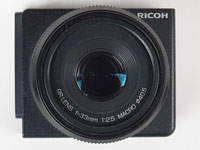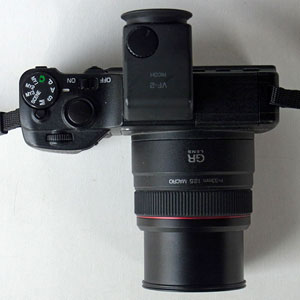Ricoh GXR: Camera Unit A12-50
Introduction to the A12-50 Camera Unit | Photos of the Camera Unit Attached to the Body | A Hidden In-Built Lens Hood for the A12-50 | Experiences | Conclusions | Links
Archive
On this page, I collect information about the Ricoh GXR A12-50 camera unit, also called lensor or module.
Introduction to the A12-50 Camera Unit
The A12-50 camera unit contains an APS-C size sensor (CMOS, total pixels: approx. 12.9 million, effective pixels approx. 12.3 million) with a focal length of 33 mm that is equivalent to 50 mm. It corresponds to a standard lens for a (D)SLR and features a macro mode allowing magnifications up to 1:2 (closest distance is 7cm). It has a focus ring, which regrettably is not purely manual, but "by wire." There are also no depth of field indicators on the lens body, but depth of field information is provided in the viewfinder or on the LCD screen when focusing manually. Also note that A12 camera units do not incorporate a vibration correction (also called anti-shake correction).
Photo: GR Lens A12-50 mm equiv. F2.5 MACRO
The unit offers a nice lens hood that can be pulled out (see below). At first, I did not realize this feature...
Finally, I should add that this camera unit is able to capture videos in HD 720p format.
Photos of the Camera Unit Attached to the Body
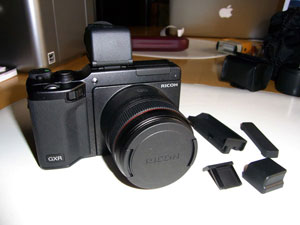 |
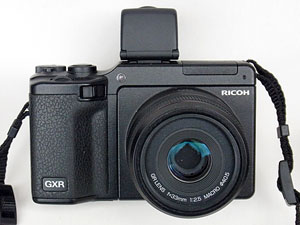 |
Photos: Body with A12-50 camera unit attached (plus some plastic covers on the left...)
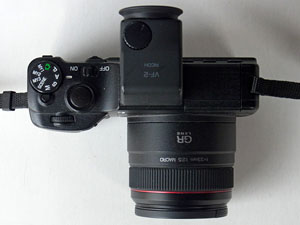 |
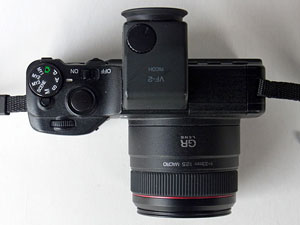 |
Photos: Top view of body with A12-50 camera unit attached - "off" (left) and "on" (right)
Photo: Top view of body with A12-50 camera unit attached - "on" in macro mode (it's not the lens hood!)
A Hidden In-Built Lens Hood for the A12-50
It was only until I read the review of the GXR with A12-50 on dpreview until I learned that the A12-50 offers a "hidden" in-built lens hood that you can pull out:
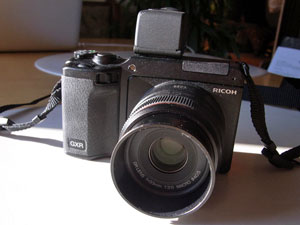 |
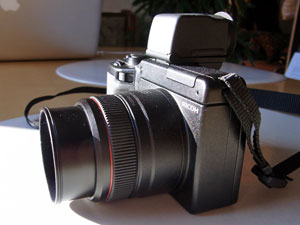 |
|
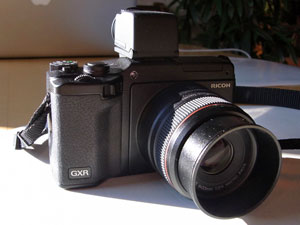 |
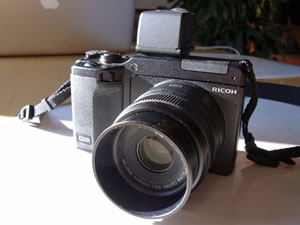 |
Photos: In-built lens hood for the A12-50
Experiences
The image quality of this camera unit has been praised by most reviewers, although not by all. ISO performance is very good up to ISO 1600 (according to my experience), but somewhat hampered by visible banding beginning at ISO 800/1600 due to the CMOS sensor. All in all, it is comparable to an APS-C DSLR, which comes at no surprise.
Autofocus performance of this unit has always been blamed, but has been improved when Ricoh introduced a new quick focus mode in a firmware update (1.17) in summer 2010. The downside of this new mode was that the screen froze during focusing, which was an issue particularly for free-hand macro shots and for shots in low light. In addition, they introduced two macro ranges, which did not overlap, in order to speed up focusing in macro mode.
In October/November 2010, Ricoh released a new firmware (1.29) update. It dramatically improved autofocus speed and did away with the quick focus macro mode, which looked more like a quick "hack." Ricoh also changed the two macro ranges so that they overlap now, which makes them more usable. After the second firmware update, this unit has become usable indeed, including macro shots (there are still occasions, in which the AF fails, though...).
All in all, this camera unit can be regarded as a high performance unit, and I was amazed to learn how much you can do with a focal length of 50 mm, that is, how flexible it is. All those zooms that I have used in the past have really spoilt me! In addition, the macro capability is very important for me, and the initial and frustrating focusing issues in macro mode seem to have gone most of the times. Sometimes, I still revert to manual focusing, and sometimes I return to AF - I am still undecided here... The last firmware update also added more screen magnifications (2x, 4x, 8x), which help with manual focusing.
Although I had and still have focusing issues with the macro mode (samples: Macro Comparisons), I like this camera unit especially because it has a macro function. Compared with small sensor units (P10, S10), taking macro shots is much more difficult and challenging because of the shallow depth-of-field (DOF). However, wenn you get it right, images look so much better. Only recently (summer 2014), I discovered that this camera unit can be used together with close-up lenses, or better, achromats to extend its magnification in macro mode. With a +5 lens you can achieve a magnification of about 1:1. See page Close-Up Lens Experiments (A12-50) for details.
I did a lot of test shots with the A12-50 camera unit when it was new. You can find them on this site in the "Sample Photos" section (see Links).
Conclusions
With its APS-C sensor, the A12-50 camera unit offers an image quality comparable to that of DSLRs. That's what I was aiming at when I bought the GXR, and Ricoh satisfied my wishes. The only issue with image quality that I have is visible banding in night shots due to the CMOS sensor. It is more pronounced at higher ISO but can already be detected at ISO 400 or even ISO 200 with the respective motifs (mostly dark night scenes).
Autofocus speed and accuracy had been an issue initially and were often criticized. Ricoh addressed this in a "two-step" approach and finally solved most of the problems. Macro AF may still be somewhat slow or miss the target - here I often switch to manual focusing.
Personally, I am fine with a focal length of 50 mm, while other people prefer of focal length of 35 or 40 mm. A 28 mm option, which many people prefer to 50 mm, is available since late 2010, and I own that as well. I am glad that the A12-50 unit has a macro function, which I use often (other people may have different preferences...).
All in all, it took Ricoh about a year to turn this unit into what it promised to offer from the beginning - but since then I am satisfied with it.
Links
Ricoh Links
- Technical data: ricoh.com/r_dc/gxr/specs.html#04
- Description: ricoh.com/r_dc/gxr/unit.html
Links to Pages on this Site
- My Equipment
- ISO Comparisons
- Macro Comparisons
- Close-Up Lens Experiments (A12-50)
- Tungsten Samples A12-28 ISO 800-3200, Daylight Samples A12-28 versus A12-50
- A12 Converter Experiments
- A12 Converter Experiments (2)
- A12-28 Comparisons: Tungsten Samples A12-28 ISO 800-3200, Daylight Samples A12-28 versus A12-50
- Issues (only some of the issues refer to the A12-50)
- Astronomy: A12-50 - Part 1
- Astronomie: A12-50 - Part 2
| 19.11.2020 |
